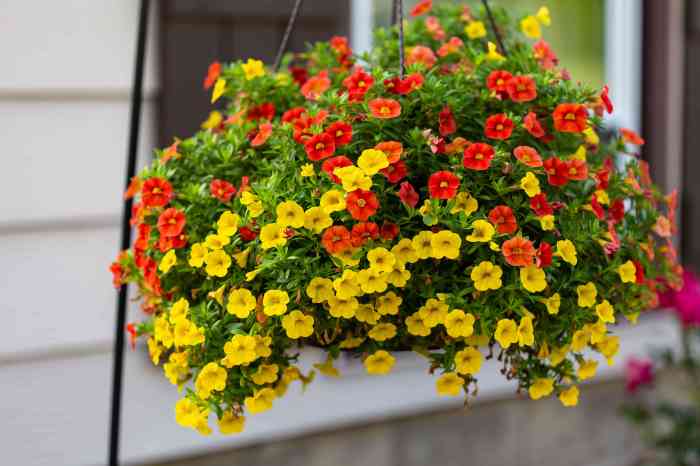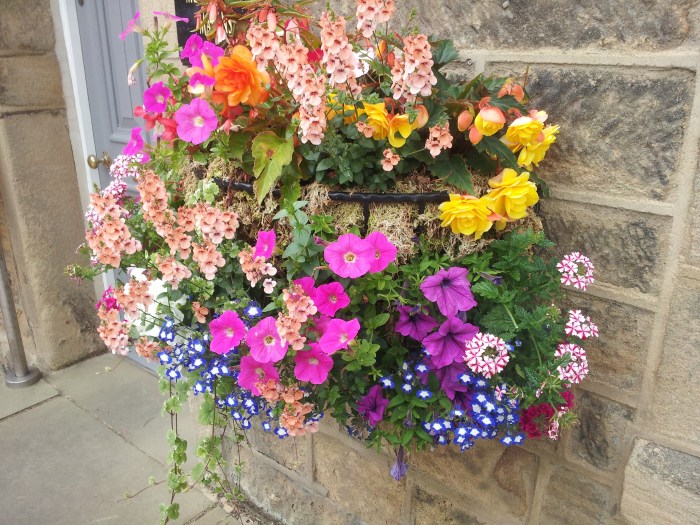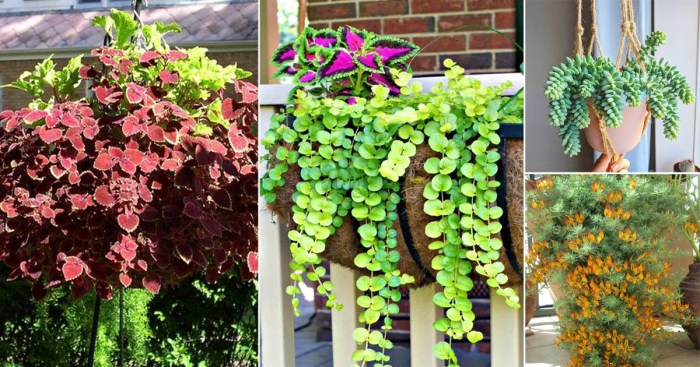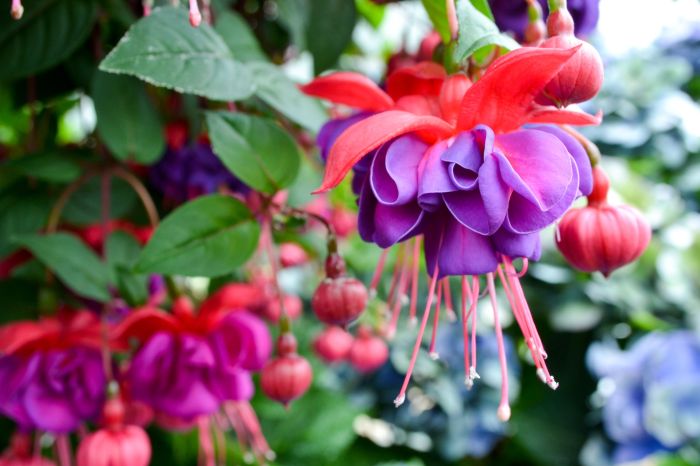Hanging basket plants drooping is a common problem that can be caused by a variety of factors. Understanding the causes of this issue is crucial for taking appropriate measures to revive and maintain the health of these plants. This article delves into the underlying reasons behind hanging basket plants drooping, providing practical solutions to address this problem.
Regular watering is essential for the well-being of hanging basket plants. However, overwatering and underwatering can both lead to drooping leaves. Sunlight requirements also play a significant role, as these plants need sufficient sunlight to thrive. Nutrient deficiency, pest infestations, and disease can further contribute to drooping plants.
Choosing the right container and soil, along with ensuring proper drainage and aeration, is vital for optimal plant growth.
Water Management

Maintaining adequate hydration is crucial for the well-being of hanging basket plants. Regular watering ensures a consistent supply of moisture to the root system, facilitating nutrient uptake and promoting healthy growth.
Determining Watering Frequency
The optimal watering frequency varies depending on factors such as plant species, container size, and environmental conditions. As a general rule, plants in smaller containers require more frequent watering than those in larger ones. Additionally, plants exposed to direct sunlight or high temperatures may need to be watered more often.
Overwatering
Excessive watering can lead to waterlogged soil, which restricts oxygen flow to the roots and promotes root rot. Symptoms of overwatering include yellowing leaves, wilting, and stunted growth.
Drooping hanging basket plants can be a frustrating sight. While some plants naturally cascade over the edges of their containers, others may be struggling due to factors such as overwatering, lack of sunlight, or nutrient deficiencies. If you’re looking for a low-maintenance option, consider hanging basket vine plants , which are known for their trailing stems and ability to tolerate various conditions.
With proper care, these plants can add a touch of greenery and elegance to your indoor or outdoor space, even when other hanging basket plants are drooping.
Underwatering
Insufficient watering can cause plants to wilt, develop dry, crispy leaves, and eventually die. Prolonged underwatering can lead to permanent damage to the root system.
Sunlight Requirements
Sunlight is a crucial factor for the well-being of hanging basket plants. Understanding the ideal light conditions and adjusting exposure accordingly can help maintain their health and beauty.
To determine the amount of sunlight a plant receives, observe its position in relation to the sun’s path. Consider the duration and intensity of direct sunlight, as well as the presence of shade from surrounding structures or plants.
Direct Sunlight
- Suitable for plants that require full sun, such as petunias, geraniums, and lantana.
- Provides optimal light for photosynthesis and growth.
Partial Shade
- Ideal for plants that prefer indirect or filtered light, such as impatiens, begonias, and ferns.
- Protects plants from intense heat and sunburn.
Adjusting Sunlight Exposure
- If a plant is receiving too much direct sunlight, move it to a shadier location or provide shade with a canopy or shade cloth.
- If a plant is not receiving enough sunlight, move it to a sunnier location or consider using grow lights to supplement natural light.
Nutrient Deficiency

Nutrient deficiency in hanging basket plants can manifest through various symptoms, such as stunted growth, yellowing leaves, and poor flowering. Diagnosing specific nutrient deficiencies requires observing the specific symptoms and matching them to the corresponding nutrient deficiency.
Fertilizing Hanging Basket Plants, Hanging basket plants drooping
Fertilizing hanging basket plants is crucial for providing essential nutrients. A balanced fertilizer containing nitrogen, phosphorus, and potassium (NPK) should be used. The frequency of fertilization depends on the type of plant and the growing season. As a general rule, fertilize hanging basket plants every 2-3 weeks during the growing season.
Pest and Disease Management: Hanging Basket Plants Drooping

Hanging basket plants are susceptible to a variety of pests and diseases that can affect their health and appearance. Proper identification and timely management of these issues are crucial for maintaining the vitality of these plants.Common pests that infest hanging basket plants include aphids, spider mites, whiteflies, and mealybugs.
Hanging basket plants can droop due to various reasons, including underwatering, overwatering, insufficient sunlight, or nutrient deficiencies. To address these issues, consider exploring the wide selection of hanging basket plants available at hanging basket plants b&m . These plants come in a range of varieties, offering diverse options to revitalize your hanging baskets and enhance their aesthetic appeal.
With proper care and attention, hanging basket plants can regain their vibrant foliage and continue to add charm to your indoor or outdoor spaces.
Aphids are tiny, soft-bodied insects that feed on plant sap, causing leaves to yellow and wilt. Spider mites are microscopic arachnids that spin webs on the undersides of leaves, causing them to turn brown and drop off. Whiteflies are small, white insects that feed on plant sap, leaving behind a sticky residue.
Mealybugs are small, cottony insects that attach themselves to stems and leaves, causing yellowing and wilting.Diseases that can affect hanging basket plants include powdery mildew, botrytis blight, and root rot. Powdery mildew is a fungal disease that causes a white powdery growth on leaves and stems.
Botrytis blight is a fungal disease that causes brown spots on leaves and stems, which can eventually lead to plant death. Root rot is a fungal disease that attacks the roots of plants, causing them to rot and die.Effective control and prevention measures for pests and diseases include:
- Regularly inspecting plants for signs of infestation or disease.
- Using insecticidal soap or neem oil to control pests.
- Applying fungicides to prevent and treat diseases.
- Removing and destroying infected plant parts.
- Practicing good sanitation by cleaning and disinfecting pots and tools.
- Providing proper ventilation to reduce humidity and prevent fungal growth.
- Choosing disease-resistant plant varieties.
By implementing these measures, hanging basket plant owners can minimize the impact of pests and diseases, ensuring the health and beauty of their plants.
Container and Soil Considerations

Hanging basket plants thrive in containers that provide adequate drainage, aeration, and support for their root systems. Selecting the right soil is also crucial to ensure optimal plant growth and prevent issues like root rot.
Hanging basket plants can sometimes suffer from drooping, which can be caused by various factors such as underwatering, overwatering, or lack of sunlight. If your hanging basket plants are drooping, it’s important to check for these potential causes and adjust your care routine accordingly.
One effective solution for drooping hanging basket plants is to choose trailing varieties that are specifically designed to cascade over the edges of containers. Trailing hanging basket plant 7 offers a wide selection of these types of plants, which can help to create a lush and vibrant display while minimizing the risk of drooping.
Container Selection
Choose containers with drainage holes to prevent waterlogging. The size of the container should be proportionate to the plant’s root ball. Larger containers are suitable for plants with extensive root systems, while smaller containers are ideal for smaller plants.
Consider the material of the container as well. Plastic containers are lightweight and affordable, but they can become brittle over time. Ceramic or terracotta containers are more durable and provide better insulation, but they are heavier.
Soil Selection
Hanging basket plants require well-draining soil that is rich in organic matter. A mixture of potting soil, peat moss, and perlite or vermiculite is a good option. These materials provide a balance of moisture retention, drainage, and aeration.
Avoid using garden soil in hanging baskets, as it can become compacted and impede drainage. It is also important to avoid over-fertilizing, as this can lead to salt buildup and damage the plant’s roots.
Drainage and Aeration
Proper drainage and aeration are essential for hanging basket plants. Ensure that the drainage holes are not blocked and that the soil is not too compacted. Adding a layer of gravel or broken pottery to the bottom of the container can further improve drainage.
Mixing perlite or vermiculite into the soil helps improve aeration. These materials create air pockets in the soil, allowing oxygen to reach the plant’s roots. Regular repotting can also help prevent soil compaction and ensure optimal drainage and aeration.
Wrap-Up
By addressing the underlying causes of hanging basket plants drooping, gardeners can effectively revive and maintain the health of these plants. Regular watering, adequate sunlight, proper nutrient supply, effective pest and disease management, and appropriate container and soil selection are key factors in ensuring the vitality of hanging basket plants.
FAQ Explained
Why are my hanging basket plants drooping?
Hanging basket plants can droop due to various reasons, including underwatering, overwatering, lack of sunlight, nutrient deficiency, pest infestations, or diseases.
How often should I water my hanging basket plants?
Watering frequency depends on factors such as plant type, weather conditions, and container size. Generally, water when the soil feels slightly dry to the touch.
How much sunlight do hanging basket plants need?
Most hanging basket plants prefer bright, indirect light. However, some varieties may tolerate partial shade or full sun.